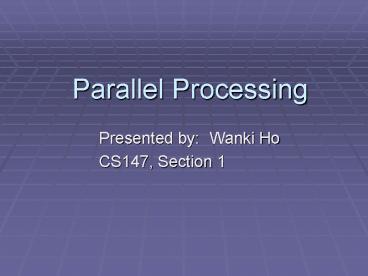Parallel Processing - PowerPoint PPT Presentation
1 / 16
Title:
Parallel Processing
Description:
Parallel Processing Presented by: Wanki Ho CS147, Section 1 The single processor problem Question: Why is parallel processing necessary? Reasons for needing ... – PowerPoint PPT presentation
Number of Views:41
Avg rating:3.0/5.0
Title: Parallel Processing
1
Parallel Processing
- Presented by Wanki Ho
- CS147, Section 1
2
The single processor problem
- Question Why is parallel processing necessary?
3
- Reasons for needing computational power
- Longer time to completion
- Higher complexity
- More detail
- Solutions must be found within a reasonable time
by human standards
4
- Examples of computational problems
- Weather prediction
- Air traffic simulations
- DNA mapping
- Big challenges
- Computer AIs
5
- Underlying problem Need more memory and speed
- The solution Parallel processing
- Connect a lot of computers together using an
interconnection network so that they act together
6
Types of Parallel Processors
- Various types depending on how the processors
interact with memory - Flynns Taxonomy
- SISD Single Instruction Single Data Stream
- SIMD Single Instruction Multiple Data Stream
- MISD Multiple Instruction Single Data Stream
- MIMD Multiple Instruction Multiple Data Stream
7
- SISD
- Von Neumann architecture. Your typical everyday
computer - MISD
- Wierd stuff. Noone uses.
- SIMD
- Computers with special instructions for handling
large data in parallel (ex. Array processor in
Intels MMX chip)
8
- MIMD
- Many processors performing operations on many
data - Multiprocessors
- Networks of interconnected computers
9
Parallel Processing Problems
- Multiple processors accessing the same memory.
- What happens if one processor reads and another
processor writes to the same block of memory? - How do two processors maintain separate caches
concurrently?
10
Network Topologies
- Bus Network
- Ring
- Tree
- Mesh
- Hypercube
- Complete Connectivity
11
Ring
- Every computer has two branches connecting it to
another computer or outside the ring
12
Tree
- Computers are connected to each other in a tree
structure
13
Mesh
- Each computer is connected to the computer below
and above and to the left and right of it
14
Hypercube
- Each computer is connected to 4 other computers
- Consistent distance between two computers.
Useful for weight balancing
15
Complete Connectivity
- Each computer is connected to every other
computer in the network - Optimal connectivity
- Complexity grows geometrically
16
- The End































